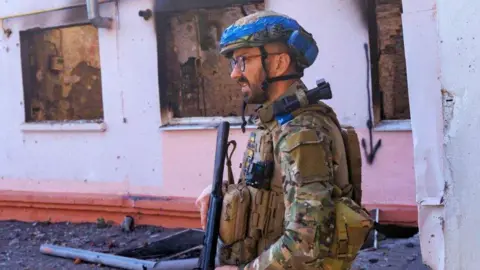In the chaotic aftermath of Bashar al-Assad’s regime collapse in Syria, one place has drawn hundreds desperate for answers: Saydnaya prison, a symbol of the regime’s brutal oppression. For decades, this notorious military complex held tens of thousands who dared oppose Assad’s rule, many of whom vanished without a trace. Now, with prisoners being freed, families cling to hope of finding those who disappeared behind Saydnaya’s walls.
Jwan Omar, a Syrian now living in Turkey, is one of those searching. On Sunday, he made the journey to Saydnaya to find his father-in-law, who was arrested in 2013 on accusations of aiding the opposition. “I went to the prison and showed photos of my father-in-law, but nobody recognized him,” Omar said. “My wife dreamed for 11 years of finding her father. Our hopes were raised when we heard prisoners were released, but my wife has been crying since yesterday.” Omar learned that many detainees had been moved elsewhere, dashing his family’s fragile hopes.
Omar was accompanied by his friend, Dr. Sharvan Ibesh, the chief executive of the Syrian aid organization Bahar, who described scenes of chaos at the prison. Hundreds of families gathered, desperate to find their loved ones among the released. “People were coming out of the prison, and we were told we couldn’t go in because the crowds were getting in the way of the rescuers,” Dr. Ibesh said. The White Helmets, a Syrian civil defense group, has been searching the prison for secret underground cells based on accounts from former prisoners, but no such locations have yet been found.
For the Nadaf family from Idlib, the search continues for Thaer Nadaf, who was arrested in 2011. At the time, he had two young children—a two-year-old and a newborn. Now 12 years old, his son Mustafa said, “I hope he comes back. I swear I miss him. I have never heard his voice.” Thaer’s mother, Fayzah, has sent her other son, Mohammad, to Damascus to find him, clinging to a doctor’s claim that Thaer is still alive and held in Saydnaya’s underground cells. “He has been missing for 12 years,” Fayzah said. “I prayed every day that he could see his children again.”
Amid the chaos, a mosque 20 kilometers from the prison has become a meeting point for newly released prisoners and their families. On a visit there, Dr. Ibesh encountered scenes of trauma. He described two men who had just been freed, disoriented and unable to answer basic questions like their name or age. “They were totally lost, just staring ahead,” he said, adding that their physical and mental state made it difficult to guess how long they had been held.
The release of prisoners has brought emotional reunions for some, but the majority remain trapped in uncertainty. Groups like the Association of Detainees and the Missing in Saydnaya Prison (ADMSP) estimate that hundreds of thousands were detained in facilities like Saydnaya during Syria’s civil war, which began in 2011. Human rights organizations have documented widespread torture and abuse in these detention centers, often describing them as death camps.
For families like the Omars and Nadafs, the hope of reunion is tempered by the agony of years lost and the grim realities of Assad’s regime. As Syria begins to piece together a future after his fall, the shadows of Saydnaya and its countless untold stories continue to haunt those left behind.




